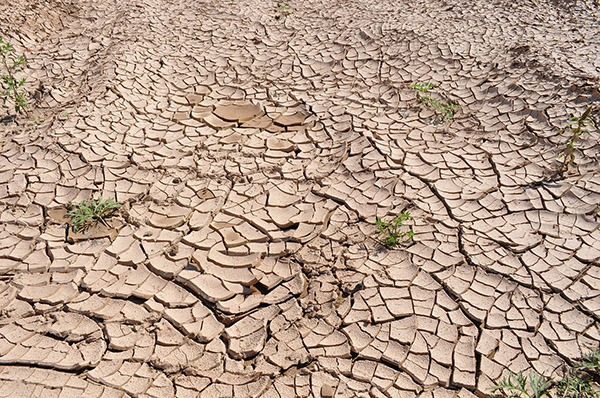
by Catherine Hudson Monday, April 20, 2015

About 30 percent of the world's people live in water-stressed parts of the world, where more than 40 percent of available water resources are being used. Credit: CC0 1.0
Roughly 30 percent of the global population — or about 2.2 billion people — lives in water-stressed parts of the world, where high freshwater withdrawals endanger ecosystems, agriculture and drinking-water supplies. If current population and water usage trends persist, this fraction could rise to about one-half by the century’s end. In a recent study, researchers — taking a page from the climate-change mitigation literature — have proposed a “wedge” approach to address global water stress, laying out how various tactics could ease the growing problem.
A water-stressed region is one “where greater than 40 percent of the water [available] is being used” by people, says Tom Gleeson, a hydrogeologist McGill University in Montreal and a co-author of the study, published in Nature Geoscience. The most water-stressed areas of the world tend to be in developing countries with high population densities, such as in parts of Asia and the Middle East.
The proportion of people living in water-stressed areas offers an indicator of the impact of water stress globally and regionally, as well as a useful metric to measure changes in this impact, according to Gleeson and his colleagues.
Working with a numerical model to assess global water resources, the team studied how six different strategies, or wedges, would need to be implemented to quantitatively reduce water stress. Specifically, they investigated how each wedge could reduce the number of people living in water-stressed areas by 2 percent globally by 2050 relative to a “business-as-usual” projection based on current trends.
The approach of projecting the savings of various water-management strategies into the future is one the team borrowed from analyses of climate-change mitigation. In that case, wedges refer to different strategies that could slow carbon emissions by a given amount over a certain timeframe — 1 gigaton of carbon over a 50-year period, for example. The idea is to combine enough wedges to stabilize or decrease future emissions to meet an overall target. In the new study, Gleeson’s team adapted the notion, proposing that “water-stress wedges” may be useful conceptual tools to shape regional water policies.
Four of the six strategies considered are so-called “soft” strategies aimed at reducing water use, or demand. These included increasing the amount of food grown per unit of water consumed, increasing irrigation efficiency, reducing domestic and industrial water use, and slowing the rate of population growth. The other two are “hard” strategies that involve traditional infrastructure projects to increase water supplies, Gleeson says. In particular, he and his team focused on increasing storage in reservoirs and ramping up desalination of seawater.
Their modeling indicated, for example, that agricultural productivity — or “crop per drop” — would need to increase globally by about half a percent per year for that strategy to reduce the world’s water-stressed population by 2 percent by 2050. Similarly, irrigation efficiency would need to rise about 1 percent per year to achieve the same reduction.
However, Gleeson acknowledges that the full 2 percent reduction associated with some of the wedges will be hard to achieve, and that each has downsides as well. For example, switching from flood irrigation practices to using sprinklers could greatly reduce the amount of water used to irrigate agricultural basins, thereby increasing irrigation efficiency. But this change could be costly for capital-strapped countries, and soil salinization could result due to the decreased volume of water flushing through the soil, thus harming crop productivity.
Meanwhile, increasing reservoir storage would require significant investments in infrastructure and could have negative impacts on surrounding ecosystems.
Although each wedge should help decrease water stress, the potential impacts for each area would have to be thoroughly assessed before being implemented, Gleeson says. And decisions about whether to actually implement any of the strategies would need to be made by regional or local authorities, Gleeson and his colleagues noted.
These wedges are “a way to illustrate … options to reduce the total and per capita water consumption,” says Dieter Gerten, a geographer and hydrologist at the Potsdam Institute for Climate Impact Research in Germany, who was not involved with the study. The study helps highlight “which specific approaches — for example, more efficient irrigation or lower demand for water-intensive products — are best suited for particular regions.”
Many people and governments recognize that water availability is a major concern, but implementing the wedges recommended by Gleeson’s team will meet resistance, Gerten says. “Water use in the U.S. and many other countries still follows the tradition of seeking more and more water in order to fulfill demands that are taken as givens,” he says. “The challenge now is to take the water supply as a given and to adjust the demand.”
© 2008-2021. All rights reserved. Any copying, redistribution or retransmission of any of the contents of this service without the expressed written permission of the American Geosciences Institute is expressly prohibited. Click here for all copyright requests.